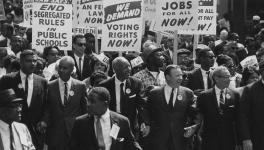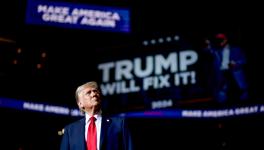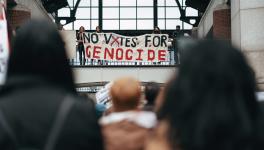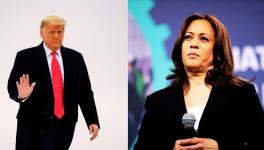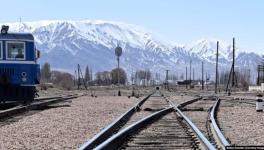Quad Meets ‘Saigon Moment’
US Vice-President Kamala Harris (L) being presented with a spray of orchids named after her, as Singapore Prime Minister Lee Hsien Loong (R) looks on, Singapore, August 23, 2021
The regional tour of Southeast Asia by US Vice-President Kamala Harris got inundated with a tsunami of criticism over the United States’ frantic efforts to complete the evacuation out of Kabul Airport by the month-end. Again, Israel being a hugely attractive topic in US news cycles, Harris’ visit to Singapore and Vietnam may get marginalised with the arrival of the new Israeli Prime Minister Naftali Bennett in Washington later today.
However, Harris’ tour is far more substantive, since the elephant in the room is China. Harris’ articulation on China, its content and cadence alike, is keenly noted in the region and its perceptions about the rocky tense US-China rivalry are critical, since it is also a region of “swing states.”
This is the first sampling — rather, the second, if the G7 Leaders meeting on Tuesday on Afghanistan is also to be counted — of the US’ standing as global leader. The G7 didn’t go too well for the Biden Administration with Washington stonewalling the European allies’ demand to extend the deadline beyond August 31 for the evacuation at Kabul Airport. It left a lot of bad taste in the mouth.
The acerbic remark by the European Council president Charles Michel following the G7 meeting on the lesson to be drawn out of the events relating to Afghanistan was that “These events show that developing our strategic autonomy, while keeping our alliances as strong as ever, is of the utmost importance, for the future of Europe. In due time, I will propose a discussion on this question to my fellow leaders of the European Council.”
A day after the G7 meeting, German Chancellor Angela Merkel said in Berlin that Germany is in favour of negotiations with the Taliban, as they are “now a reality in Afghanistan… The developments of the last few days are terrible, they are bitter.” Germany since began discussing a new road map directly with the Taliban officials in Kabul regarding evacuation beyond August 31.
How can the mood in Southeast Asia be any different? There is going to be extreme wariness in the region about the US’ anti-China rallying cry. This is the “Saigon moment”. Memories of the US’ departure from Saigon 47 years ago are creeping up from the attic of the region’s collective consciousness. Abandonment of allies dents the credibility of a superpower.
The region may not always resort to plain speaking. Thus, on Tuesday, just before Harris’s arrival in Hanoi, the Vietnamese Prime Minister Pham Minh Chinh received the Chinese Ambassador to Vietnam Xiong Bo.
According to the Chinese Embassy in Hanoi, Chinh underscored during that meeting the importance of the strategic communication between Hanoi and Beijing and cooperation in inter-Party, foreign affairs, national defence, and public security, and voiced the need to guard against the “peaceful evolution” of hostile forces and attempts to sow discord between Vietnam and China.
The symbolism is profound. Harris is the second high-level US dignitary to visit Hanoi in two months — after Defence Secretary Lloyd Austin’s July visit. Hanoi has signalled to Beijing that while it is to Vietnam’s advantage to keep the US on its side, Vietnam-China relations are also stable and Hanoi’s special relationship with Beijing — being socialist countries and neighbours — and the flourishing bilateral economic and trade relations are virtually in a special category by itself.
Harris’ remarks at Singapore from a public forum on the Indo-Pacific region hinted at a need post-Afghanistan for the US to reposition itself in the Asia Pacific while engaging the broader region’s perceptions of the US’ global priorities and strategic intentions. Significantly, this was also the public advice given to Harris by Singapore Prime Minister Lee Hsien Loong.
Lee said at a joint press conference with Harris, “we are watching what is happening in Afghanistan on the TV screens today. But what will influence perceptions of US resolve and commitment to the region will be what the US does going forward – how it repositions itself in the region; how it engages its broad range of friends and partners and allies in the region; and how it continues the fight against terrorism.
“Countries make calculations and take positions, and they have to make recalculations and adjust their positions from time to time. Sometimes it can be done smoothly; sometimes there are hiccups; sometimes things go awry and take time to put right. But countries remain with long-term interests, with long-term partners, and it is a mark of a country which can succeed that it takes these interests and partners seriously and in a dispassionate way, and maintains them over the long term. And the US has been in the region since the war, which is more than 70 years ago.
“There have been ups and downs; there have been difficult moments; there have also been, over decades, dramatic transformations in Asia, wrought by the benign and constructive influence of the United States, as a regional guarantor of security and support of prosperity. Singapore hopes and works on the basis that the US will continue to play that role, and continues to engage the region for many more years to come.”
At any rate, Harris’ remarks Tuesday on Indo-Pacific had none of that strident aggressive anti-China rhetoric, characteristic of US officials. Harris took one single swing at China, saying, “we know Beijing continues to coerce, to intimidate, and to make claims (in South China Sea)… And Beijing’s actions continue to undermine the rules-based order and threaten the sovereignty of nations.”
But her signal tune was that the US engagement in Southeast Asia and the Indo-Pacific is “not against any one country, nor is it designed to make anyone choose between countries. Instead, our engagement is about advancing an optimistic vision that we have for our participation and partnership in this region. And our economic vision is a critical part of that.”
Her remarks were peppered with such conciliatory sentiments — about a “more interconnected and interdependent world”; the need to “take on challenges together and create opportunities together”; the recognition that “our common interests are not zero-sum”; and how in an interconnected world, collective vision and collective action are a must.
Harris did not accuse Beijing of condoning “the campaign of violent repression” in Myanmar. Nor did she mention Hong Kong, Xinjiang, Tibet, et al. Interestingly, Harris bracketed the Quad and the US-Mekong Partnership in the same league as “new results-oriented groups.”
While Harris is still in the region, word comes from Washington that President Joe Biden’s climate envoy John Kerry is heading for China next month for a second time since April. And reports appeared also that the Biden Administration has approved the sale of some vehicle chips to Chinese leading technology company Huawei, and more such sale licenses may be in the offing, effectively reversing the Trump administration’s moves to block sales.
The Southeast Asian business community must be clued in on the tidings from Washington that pressure is building on the Biden administration to eliminate tariffs on imports from China both to stimulate trade (which is buoyant as it is despite political tensions) as well as to curb inflation in the US economy. On August 5, more than 30 major business organisations in the US spoke with one voice suggesting that a deal on cutting tariffs with China might already be underway.
Courtesy: Indian Punchline
Get the latest reports & analysis with people's perspective on Protests, movements & deep analytical videos, discussions of the current affairs in your Telegram app. Subscribe to NewsClick's Telegram channel & get Real-Time updates on stories, as they get published on our website.









